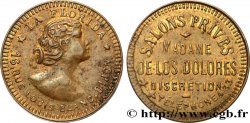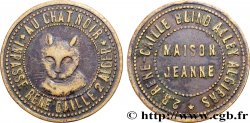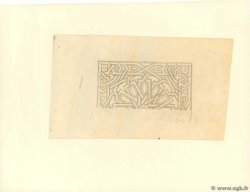fjt_993716 - MAISONS CLOSES ET DIVERTISSEMENTS Tien-Tsin, jeton de club n.d.
No disponible.
Artículo vendido en nuestra tienda (2025)
Precio : 120.00 €
Artículo vendido en nuestra tienda (2025)
Precio : 120.00 €
Tipo : Tien-Tsin, jeton de club
Fecha: n.d.
Nombre del taller / ciudad: s.l.
Cantidad acuñada: 2806000
Metal: cobre amarillo
Diámetro: 32,5 mm
Eje de acuñación: 4 h.
Peso: 8,56 g.
Canto: Lisse
Cuño: sans poinçon
Grado de rareza: R1
Comentarios sobre el estado de conservación:
Jeton ayant été nettoyé, des frottements dans les champs
N° en los catálogos de referencia :
Anverso
Titulatura del anverso: NAM FONG CLUB.
Descripción del anverso: caractères chinois.
Traducción del anverso: tourné vers le Sud.
Reverso
Titulatura del reverso: NAM FONG CLUB.
Descripción del reverso: caractères chinois.
Traducción del reverso: tourné vers le Sud.
Comentario
Le mot NAM est issu des dialectes Chams, laotiens et Siamois qui signifie selon Jean Lecompte “eau ou rivière”. Le mot Fong, lui est issu du chinois et serait toujours selon Jean Lecompte à mettre en relation avec une forme de “sacrifice à caractère exceptionnel célébré par les empereurs chinois pour remercier le ciel de la réussite de leur règne”. Jean Lecompte indique également dans son ouvrage intitulé : Monnaies et jetons des colonies françaises” que Nam Fong était un quartier situé au sud de Tien-Tsin construit en partie sur l’eau. Les Clubs, maisons de passe et de jeux étaient souvent tenus par des Français expatriés d’Indochine.
The word NAM comes from the Cham, Laotian and Siamese dialects which, according to Jean Lecompte, means “water or river”. The word Fong, comes from Chinese and, according to Jean Lecompte, is always linked to a form of “exceptional sacrifice celebrated by Chinese emperors to thank heaven for the success of their reign”. Jean Lecompte also indicates in his work entitled: “Currencies and tokens of the French colonies” that Nam Fong was a district located south of Tien-Tsin built partly on the water. The clubs, brothels and gambling houses were often run by French expatriates from Indochina.
The word NAM comes from the Cham, Laotian and Siamese dialects which, according to Jean Lecompte, means “water or river”. The word Fong, comes from Chinese and, according to Jean Lecompte, is always linked to a form of “exceptional sacrifice celebrated by Chinese emperors to thank heaven for the success of their reign”. Jean Lecompte also indicates in his work entitled: “Currencies and tokens of the French colonies” that Nam Fong was a district located south of Tien-Tsin built partly on the water. The clubs, brothels and gambling houses were often run by French expatriates from Indochina.








 Informar de un error
Informar de un error Imprimir la página
Imprimir la página Comparte mi selección
Comparte mi selección Haz una pregunta
Haz una pregunta Consignar / vender
Consignar / vender
 Descriptivo
Descriptivo










